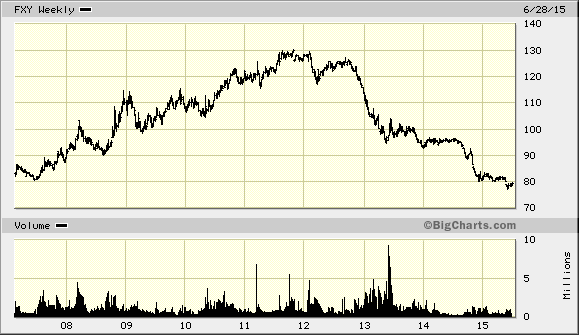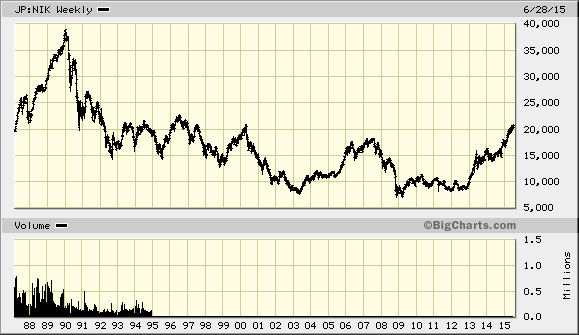NEW YORK (Dollar)
The artificial growth of the U.S. economy this year was made possible by the greatest inventory build-up in history, with many analysts even doubting the figures that cite growth in the first place. I am far from the first to have discussed these points.
The upshot of the inventory figures is that the U.S. economy has nothing that could possibly act as an engine of growth in the future directly ahead. So, the latter is very consistent with the technical and political landscape.
We have heard much of total global debt, but even more attention must be given to the size of the total of outstanding derivative contracts than what has been publicized.
Hidden behind the veils of discretion of the fee-loving and trend-compounding derivatives desks are found the incomprehensible position sizes, much of which are designed to benefit from the heretofore one-way trend and trade, known as the collapsing interest rate.
But the latter has bottomed. So, what now?
Taken from the article linked immediately below, "One of the world’s leading derivatives experts, Paul Wilmott, who holds a doctorate in applied mathematics from Oxford University, has warned that the so-called notional value of the worldwide derivatives market is over $1.4 quadrillion."
Ponder this: Deutsche Bank (XETRA:DBKGn) (where CEO heads have rolled) is reported to have a derivatives book that is a significant double-digit multiple of Germany's GDP!
Has that bank committed the national financial suicide that brings down Europe, far worse in magnitude than Lehman and Bear Stearns and, in doing so, demolished the financial structure of the only good thing that Europe had going for it?
Everyone is talking about Europe's weakest (Greece, etc.), but is the strongest soon to be laid down to (financial) ruinous rest?
Apart from the PMs, is the only investment, disinvestment?
This crucial link not only underscores a multi-decade 6.5-year cycle of major market declines; it includes a table of the relevant calamities that occurred at each peak.
Further, note that when the average decline is cited, it does not refer to the top-to bottom figures. Without going back to the mega-debacle of 1929-32, simply note the declines from the peaks in 1973, 1987, 2000, 2007 to their respective lows to have been ~50%.
I strongly encourage readers to click on and enlarge the table to spark the imagination to wonder how lengthy might be the future list that comprises the explanation of what will have been the background to this particular and possible historic event of multi-century nature, referred to in Elliott Principle as the grand Super-Cycle.
In the table, please note how Wave-5 began in ~1979, around Dow 700. When I got into the business in 1982, my mentor was called nuts when he said that the Dow would not only finally break 1000, but travel to 3000. Okay, we went to 18,000.
With all of the talk by the markets' finest minds pointing to today's global market levels as being the result of printed paper and un-repayable debt, how outlandish is the thought of unwinding? What are the logical and sober questions to ask?
1-Year Dow chart follows here:

In 2011, I identified the perfect peak in the yen, and would subsequently reiterate that analysis several times through to the decline that finally commenced a year later, with a long term forecast of 80 on the yen (~35% decline).
The recent flush-out and break under 80 was enough to push the Nikkei toward 21,000. I take great interest in this because I had forecast that a blow-off in the Dow could take the popular U.S. index to 19,700, to emulate what had occurred in 1989 in Japan.
Please note the 9-year yen ETF chart immediately below:

However, as part of the widely known currency link and play, it is the Nikkei that has been the trend-following hedge fund managers' darling equity play. More on this after the 2 Nikkei charts that follow.
The 1-year Nikkei chart immediately below reflects the move to 21,000, while the pursuant 28-year chart illustrates the seemingly impenetrable VERY long term resistance that exists at these levels.


To further appreciate the role of currencies as a determinant for managers contemplating where to invest their must-allocate funds, note the relationships in all major cases.
Concurrent with this article, I have written a report entitled, "Silver's Low Reconfirmed?" In it are included charts of the Shanghai index.
If China and Japan are set to collapse, if for no other reason than the mathematically extreme unlikelihood of rallying from their present resistance levels under ORDINARY circumstances, then what would occur once markets are let go, no longer manipulated, as so many understandably believe to be the case?
I have been writing in previous articles that the markets are awaiting particular political events to pass before letting the markets go.
Yes, a major date is October's news to come out of China regarding their gold holdings, but the event to which no attention has been paid and which is a possible magnet for serious market disruption could be events related to this October's Canadian elections.
In any event, I believe that we have seen the peak, witness the pathetic distribution pattern evident in the Dow's 1-year chart above. Moreover, it follows years of new highs on ever-waning momentum, coupled with the seemingly unending repetition of expanding triangles.
{Such patterns describe expanding volatility and conclude with spikes, though the final point in the pattern (the spike), would not happen, before the reoccurrence of the same cycle of expanding volatility; that volatility pattern would be denied its final point, which would have corrected the preceding advance.}
For these same reasons, I believe that such "new highs" ought to have NO bearing on strategy; hence, such strategies should already be in place, as I had argued the first time the Dow hit 14,000 in 2007, before reiterating the call at the same level in the 4th-quarter of that year. I advise viewing and approaching today's situation in the exact same way.
Here we are in summer, and the highs in equities are effectively in. The extremes in multiple assets and their volatility levels have already been registered (some since several months).
In 1973, 2000 and 2007, no one called the bear for what it was until the collapses came. Following the August 25, 1987 summer high, the subsequent decline preceded a strong rally that ended on October 2nd.
On the 16th, 19th and 20th, everyone was fully awake. I write these dates from memory. I remember that it was the definition of a Crash, which 2008 was NOT. A Crash is when there are dislocations, not merely "big declines."
Bids were higher than offers, and there was a sense of chaos with a resultant feeling that the authorities had lost control.
Regarding the bids and offers, the alert took advantage, but traders were only obligated to fill 10 contracts...and no one could succeed at an argument if the order was "lost on the floor of the exchange."
I remember 1-month puts bid 10% the value of the stock; I will never forget. Today, so many say, "Naw, that can't happen." That's why there are simulated drills being run for dealing with major calamities?
The attitude is that it is crazy to bet on such a thing happening. But, I ask you: with paper needing to be burnt after having been so overwhelmingly printed, is one not the gambler by assuming that bad things WON'T happen?
Or will more prudent questioning only occur too late, yet again?
